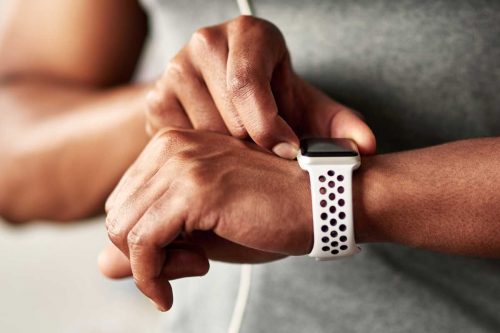If you're interested in trying Pilates, you may wonder what you need to wear--especially on your feet. Do you need shoes, socks, or should you go barefoot? We've done the research and have all the answers you need to get ready for your first Pilates class.
To make it simple, you do not wear shoes when doing Pilates. Most people go barefoot while doing Pilates or you can choose to wear non-slip Pilates socks.
Keep reading for more information on what to wear for a Pilates class, including a description of Pilates socks, recommendations for what both men and women should wear, whether you need to bring your own mat or not, and whether or not you should expect to sweat. So, without further ado, let's get to it!

Why No Shoes In Pilates
For Pilates, like yoga, you don't need to wear shoes. Supportive shoes can be helpful for other forms of exercise that involve jumping or running, but since Pilates is low-impact and involves very little time spent on your feet, shoes aren't necessary. Pilates is primarily performed either on a mat or using a machine called the reformer. For either type of class, you should not wear shoes.
In mat Pilates, most of the moves are performed either lying down, sitting, or kneeling on a mat. Not only are shoes not needed while exercising on a mat, but they could also get in your way and prevent you from completing the movements properly. During various exercises, you need to be able to fully articulate your feet, pointing or flexing your toes as directed. Shoes would not only impede your movements but also prevent the teacher from seeing if your feet and legs are aligned and moving correctly. Most people choose to go barefoot while performing mat Pilates.

In reformer Pilates, you should not wear shoes because they could prevent you from using the equipment and completing the exercises properly. Your feet need to be able to move freely to get the full benefit of each Pilates exercise. However, for hygiene purposes, some Pilates studios may require you to wear special socks rather than going barefoot while using equipment like the reformer.
What Are Pilates Socks?
Pilates socks are special socks designed to be worn while you perform Pilates. They have rubber or silicone grips on the soles that provide extra grip and traction to keep you from slipping, whether on a mat or the reformer. They are also usually low-cut/ankle-length so your teacher can see if your feet are aligned properly.
Many Pilates studios will require you to wear Pilates socks when using the reformer, but you can also choose to wear them when performing mat Pilates. If you want to wear socks to keep your feet warm while performing Pilates, make sure they have non-slip grippy soles. You could easily slip and injure yourself if you wear regular socks for Pilates.
Check out these great options below, for both women and men:
Women's Socks
Click here for these Ozaiic women's non-slip Pilates socks on Amazon.
Men's Socks
Click here for these Muezna men's non-slip Pilates socks on Amazon.
Do You Need to Bring Your Own Mat to Pilates?
Whether or not you need to bring your own mat to a Pilates class will depend on the particular gym or Pilates studio. Many gyms provide mats for members to use while they are working out or taking a class. Always check first to determine if mats are provided or if you are allowed to bring your own. Some Pilates studios may provide special mats that they prefer you to use. However, even if your gym provides a mat, you may still want to bring your own for a number of reasons.
Cleanliness
Cleaning protocols across gyms may vary, and the best way to ensure the mat you are using is clean and sanitary is to bring your own. You don't need to worry about using a mat soaked in someone else's sweat or germs, and you won't have to wonder when the mat was last cleaned or wiped down.
Style
Mats can vary in style, length, and thickness. You may prefer a thicker mat to better pad your knees, or you may prefer a mat that offers more grip to prevent sliding. Depending on your height, you might need a longer mat. The materials mats are made out of can also vary, and some may be more comfortable under your hands than others. If you choose to bring your own mat, you can ensure it meets all your needs to help you get the best possible workout.
Quality
As with anything, mats can wear out over time. They may develop tears or lose some of their grip after repeated use - especially in a large gym where the same mats may be used by many different people for a variety of different classes and workouts. The shared mats they offer might not always be in perfect condition. You won't have to worry about slipping on an old mat that's lost its grip if you bring your own.
Click here for this thick Pilates mat with an extra knee pad on Amazon.
How Should You Dress for Pilates?
You should wear form-fitting clothing that allows you to move and stretch freely. Your instructor needs to be able to check your alignment and posture, so loose, baggy clothing is not recommended. You will spend much of the class on your back or with your legs in the air, so shorts are also not recommended. Considering the time spent lying on both your back and stomach, you will be more comfortable if you also avoid clothing with zippers, buttons, buckles, or snaps.
If you will be attending a reformer Pilates class, you need to make sure your clothing doesn't have any long ties or loose straps that could get caught in the equipment. You shouldn't wear any dangling jewelry for the same reason. It's best to keep your clothing simple without any plastic or metal embellishments that could damage the upholstery of the Pilates equipment. And remember, depending on the studio, Pilates socks may be required.
Women
Wear leggings or yoga pants, either capri-length or regular, like these:
Click here for these women's IUGA high-waisted, capri yoga pants on Amazon.
Wear a tank top or other form-fitting shirt, such as this one:
Click here for this women's yoga tank top on Amazon.
Wear a sports bra or yoga bra (avoid underwire and clasps), like this one:
Click here for this FITTIN racerback sports bra on Amazon.
Men
Wear exercise pants or running tights (they can be layered underneath shorts), like these:
Click here for these men's BALEAF yoga pants on Amazon.
Wear a form-fitting T-shirt or tank top, like this one:
Click here for this men's Under Armour wicking T-shirt on Amazon.
Do You Sweat During Pilates?
You can definitely work up a sweat during a Pilates class. Just like with any workout, how much you sweat will depend on the intensity of that particular class, how hard you push yourself, and your own body chemistry, but you should expect to sweat during a Pilates class and dress accordingly.
A typical Pilates class involves a strong focus on the core, and ab exercises are often sweat-inducing. Other common moves, like leg lifts, may seem simple at first glance because you perform them lying down, but with so many repetitions, they can wear out your muscles and cause you to work up a sweat. Some Pilates moves are performed at a fast pace with few breaks in between, and others involve slow controlled movements. But fast or slow, Pilates can make your muscles burn and leave you sweaty by the end of class.
In Closing
When performing Pilates, whether on a mat or reformer, you don't need to wear shoes. Depending on the gym or studio, you can choose to go barefoot or wear non-slip Pilates socks. Now that you know what to wear, what are you waiting for? Whether in a studio or at home, you're ready to try your first Pilates class!
Here are some of our other articles you might like:













![Read more about the article How To Add Grip To Basketball Shoes [5 Crucial Tips]](https://fitseer.com/wp-content/uploads/2020/09/A-high-school-basketball-player-dribbles-between-his-legs-with-his-basketball-shoes-grips-on-the-floor-500x333.jpg)
![Read more about the article How To Clean Mesh Running Shoes? [5 Steps]](https://fitseer.com/wp-content/uploads/2020/11/Pair-of-light-breathable-summer-shoes-on-natural-wooden-board-surface-500x333.jpg)